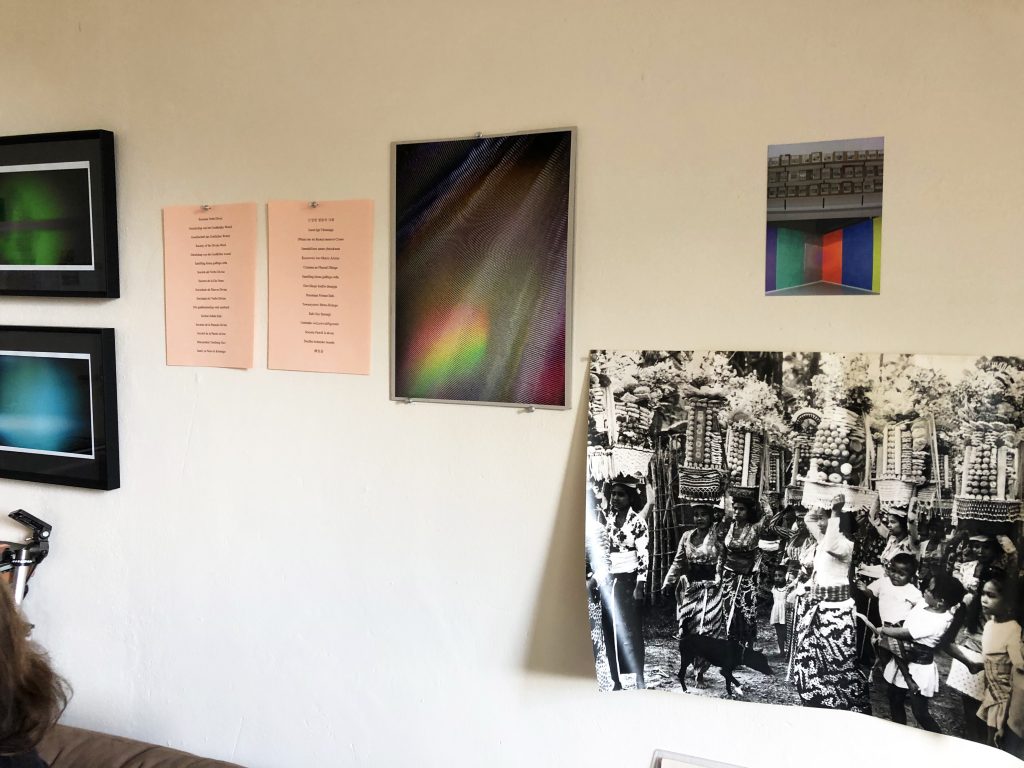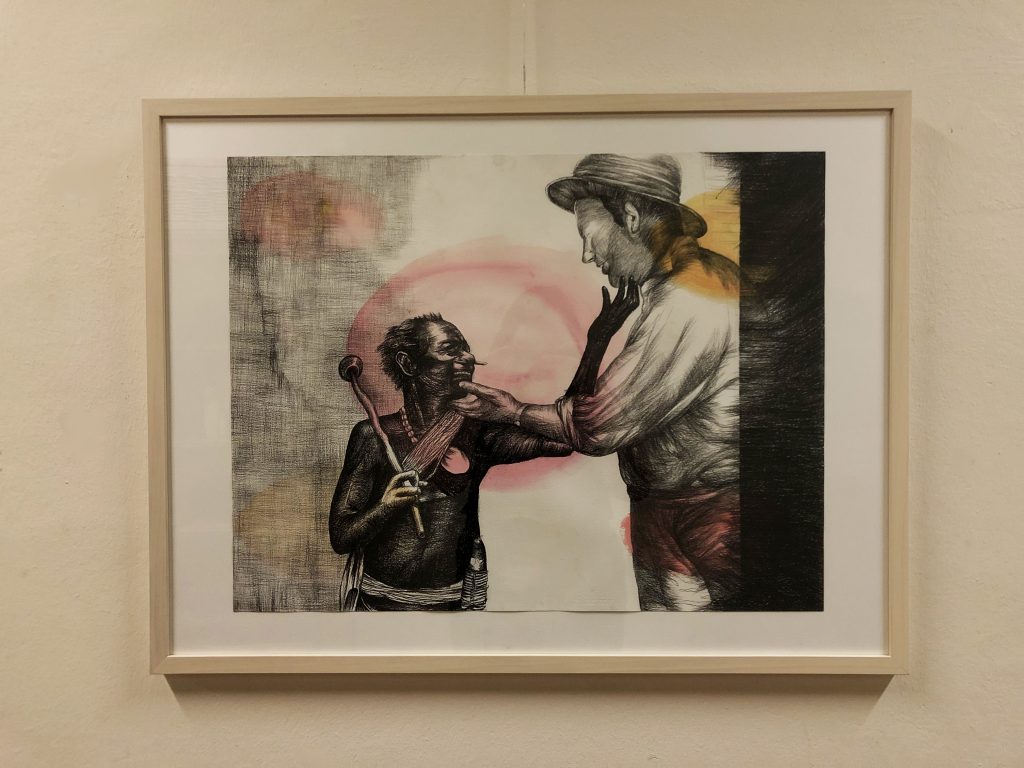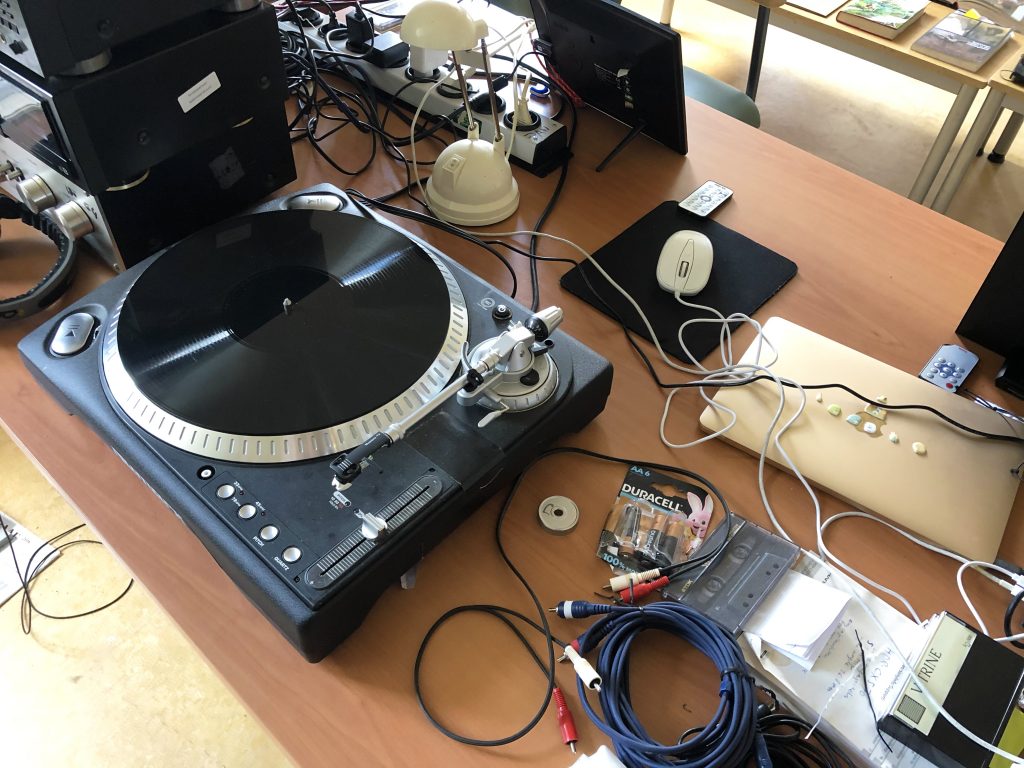
Jan Van Dobbelsteen and Danielle Lemaire, artists and life partners, have been staying in the old mission house at Park Zuiderhout in Teteringen since March, where they’ve been working on their residency amongst the religious brothers and priests living there. At the end of May, they concluded their three-month working period with a provisional on-site presentation.

‘Jan and I have collaborated on this for three months,’ Danielle tells me upon my arrival. ‘We each have our individual practice, but we can also work very well together.’ It’s not the first time that these two artists have shared a residency. Describing their collaboration, Jan says, ‘We did not have to figure out how we wanted to approach this residency. It always goes well. The same can be said of our work. In the space, it’s quite clear not only that we worked alongside one another, but also which work belongs to whom. If something is site-specific, we first figure out who will work where. It’s never chaos. We each have our own spot.’
In the spaces that the duo (who operate under the name JaDa) have occupied in the mission house’s attic, it’s clear during the final presentation who made what. Their individual styles are instantly recognisable. As I enter the corridor, I’m greeted, so to speak, by drawings by Danielle. Here, among other objects, hangs a drawing of a Christian brother and an indigenous inhabitant of Papua New Guinea, who greet one another by scratching each other’s chin. According to Jan, ‘In previous centuries, Christian missionaries from various congregations went on missions to many countries around the world to spread the word of God and to carry out development work. These brothers and priests now live here in the mission house. The wealth of stories tucked away in their experiences and memories is immense.’

The Christian brothers and priests who went on missions were dispatched to foreign countries in order to ‘win souls’. However, the missionaries also played much larger roles in the places they visited. ‘They came not only to win souls, but also to do much more,’ explains Jan. ‘Of course, the foundation for it all was a Christian ideal — that was the mission — but the missionaries were also very nearly explorers. The first thing they did was to learn the language of the group they found themselves in. If they did not speak the language, they analysed it themselves to be able to communicate on an equal level with the indigenous people. This is how the priests discovered and documented multiple languages.’
The spirt of equality with which the generation of priests and brothers now living in the mission house approached the inhabitants of where they visited was not the default just a few generations prior. The more overtly colonial mindset of the older generation of missionaries is central to Danielle’s drawing Zieltjes Winnen (winning souls). ‘The previous generation of missionaries thought, “If we gift mirrors, beads and silver foil to the inhabitants, we’ll all be friends.” The scene depicted in the drawing and the strip of aluminium foil above it refer to this act. The brothers who live here now would never do that. They dealt with the original inhabitants on a far more equal level, treating them with respect.’

The stories surrounding the missions have been an indispensable leitmotif in the residency and have crossed their path in unpredictable ways. Danielle remarks, ‘I delved into the story of a priest living here, who had worked in Papua New Guinea for fifty years. He told us he had brought back some Papuan sculptures when he returned home. We expected to find a smattering of statues and carvings, but he had put together a complete archive that filled an entire room.’ Jan adds, ‘After roughly ten days, we heard that all the sculptures and figurines had to go. The priest responsible for this collection was quite upset about this. Danielle and I then looked into whether we could act as an intermediary to ensure that the collection ended up somewhere suitable. But this detour proved too large and complicated for the plans we had already mapped out for these three months.
AIR De Missie gives artists an opportunity to explore the meaning of religion, a sense of purpose, care and spirituality in contemporary society. Danielle describes how their own practice fits with this modern-day exploration of ideas and what brought them to AIR De Missie: ‘Jan and I live and work together in a kind of spiritual community in Eindhoven: in JaDaland. In my opinion, we’re always on a mission. For AIR De Missie, our approach was to transfer this form of living and working from Eindhoven to another community: the assisted living facility. I personally feel like I function best within a community. I do think it’s important, however, to have a room set aside for introspection where I can isolate myself. All of these aspects were present here. For this residency, you actually have to become part of the whole: you eat, sleep and live in the community among the priests.’
For this residency, you actually have to become part of the whole: you eat, sleep and live in the community among the priests.’
Contact with those living at Zuiderhout Park is a priority for this residency. A third of the current residents are religious, mainly priests and brothers from diverse congregations. Jan was particularly interested in these orders and congregations. As he remarks, ‘I’ve read a great deal about the mission house, which was founded by the Roman Catholic Societas Verbi Divini in 1915: the Gezelschap van het Goddelijke Woord. I studied their history.’ Jan’s portion of the presentation space consists of numerous books, newspaper clippings, abstract videos and photos and a turntable playing an LP. He talks about the videos playing on small screens on the table: ‘There’s an internal cable television network here, which for the most part displays internal information. I produced around twelve short videos for this internal network, managing to upload a short, abstract video nearly every week. The videos are a play between abstraction, light and spatiality, and they have a very meditative effect.’ Danielle adds, ‘The residents, however, did have to actively turn on that channel themselves. We had to let them know to do that, of course. In a residency like this, you also contend with that as an artist. You have to communicate well with everyone involved in the residency ecosystem.

Post residency, Jan and Danielle will continue transforming the material they’ve gathered into the next artwork. Jan points out, ‘We plan on using all the knowledge, information, recordings and videos to produce a double LP and a book.’ Similar to how the two artists are ‘neighbours’, they’re each producing their own record, connected by an overarching theme. Danielle has recorded an enormous amount of conversations with residents over the three-month period. ‘The residents sometimes express things about music that could only come from someone who has lived in another country so long that they have a different connection with music. How you incorporate that is part of our artistic process: How do we produce a record that makes for interesting listening?’
Furthermore, all the artists involved with AIR De Missie will be exhibiting in the Stedelijk Museum Breda in January 2022. Danielle notes, ‘There, we will exhibit, among other things, the double-LP and hopefully the book that we’ll be working on in the coming months. But the presentation now on display in the mission house is really for the people who live there. This way, we can give something back to the people who welcomed us so warmly and graciously.
Author: Linda Köke

